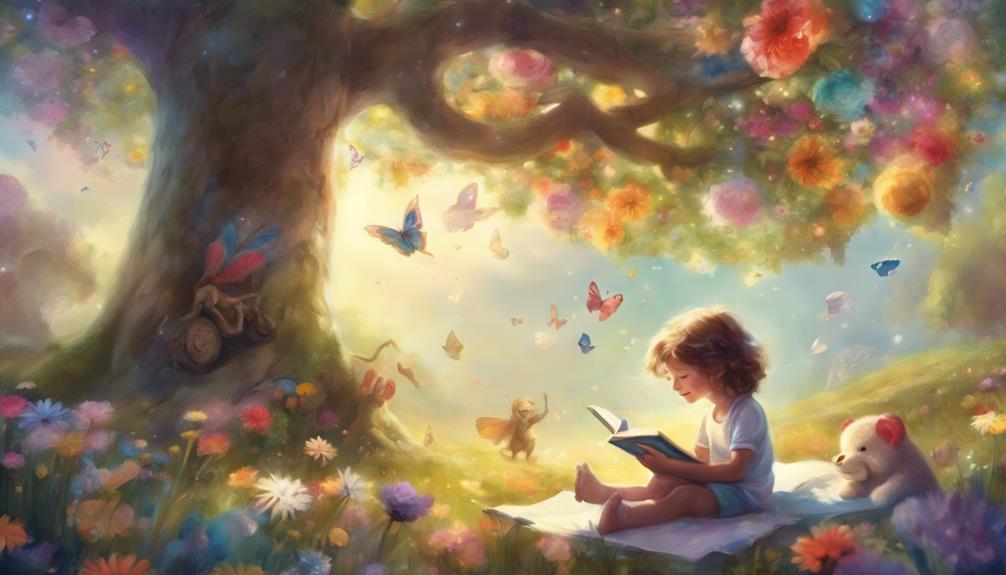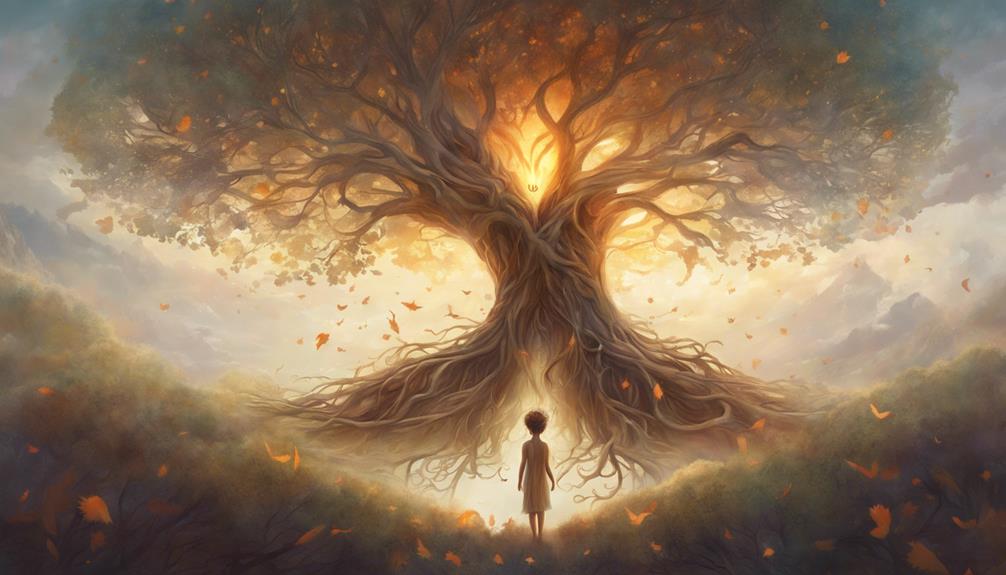Nearly 60% of adults report experiencing significant emotional challenges during childhood, suggesting a profound need for inner healing. You've likely navigated your share of these challenges, possibly carrying unresolved feelings into adulthood.
The journey towards emotional resilience and healing your inner child can start with asking yourself the right questions. Questions like 'What made you feel safe?' or 'Who truly understood you?' aren't just reflective—they're transformative. They peel back layers, revealing truths and paths to healing you might not have considered.
If you're curious about how these questions can pave the way for profound personal growth, there's a guide waiting to lead you through.
What Made You Feel Safe?

Reflecting on your childhood, consider what environments or relationships consistently made you feel secure and protected. Was it the warm embrace of a family member, or perhaps a specific place, like your room or a hidden nook in the garden, where you could always find solace? These havens, physical or emotional, played a crucial role in your sense of safety. They were more than just spaces or faces; they were your anchors in a world that, at times, seemed vast and unpredictable.
Now, think about the rituals or activities that reinforced this feeling of security. Was it a nightly bedtime story, the gentle hum of a lullaby, or maybe the comforting routine of a family meal? These moments, often simple and understated, contributed significantly to your feeling of being safeguarded against the uncertainties of life.
Understanding what made you feel safe in your childhood can be a powerful tool in your journey towards emotional resilience. It's not just about nostalgia; it's about recognizing the foundations that allowed you to thrive. By identifying these elements, you can seek to recreate similar environments or relationships in your adult life, nurturing your inner child and bolstering your emotional fortitude.
Who Truly Understood You?
Often, there was someone in your childhood who seemed to grasp the essence of who you were without much effort. This person, be it a family member, a friend, or maybe a teacher, understood your silences just as well as your words. They provided a safe space where you felt seen and heard, which is crucial for building your sense of self and emotional resilience.
Reflecting on who truly understood you can be enlightening, as it helps you identify the qualities in relationships that make you feel valued and accepted. Consider the following aspects of that relationship:
- The way they listened: Genuine, undivided attention made you feel important.
- Their ability to offer comfort: They knew just what to say or do to make you feel better.
- Recognition of your uniqueness: They celebrated the things that made you different.
- Encouragement and support: They believed in you, often more than you believed in yourself.
Understanding these aspects can guide you in fostering similar relationships today, where mutual understanding and support form the foundation. It's a step towards healing your inner child and building the emotional resilience you need to navigate life's challenges.
How Did You Express Joy?

Examining how you expressed joy during your childhood can unveil the purest forms of happiness you experienced. Remember those moments? Maybe you'd burst into laughter over the smallest things, or perhaps you found immense joy in running through the backyard, feeling the wind against your face. It's those simple, carefree expressions of happiness that often get buried under the weight of adult responsibilities.
You might've shown your joy through creative outlets, like drawing or building imaginary worlds with your toys. These weren't just ways to pass the time; they were your heart's expressions, unfiltered and genuine. Or maybe music moved you, and you couldn't help but dance when your favorite tune played, regardless of who was watching.
Think back to those times when you were so absorbed in play that nothing else mattered. Your joy wasn't just seen; it was felt by those around you. It's these forms of expression, pure and unadulterated, that can reconnect you with your inner child today.
Revisiting these memories isn't just nostalgic; it's a pathway to rediscovering what truly brings you joy. It's about acknowledging that these expressions of happiness, though perhaps more subdued now, are still a vital part of who you are.
What Were Your Dreams?
As a child, your dreams painted the skies of your imagination with vivid colors, unfolding a world where anything seemed possible. You'd lie in bed, eyes wide open, as fantasies and aspirations danced in your mind. Perhaps you envisioned yourself as an astronaut, a doctor, a teacher, or even a superhero. These dreams, no matter how grand or simple, held the essence of your purest desires and ambitions. They were a reflection of your innermost passions and a glimpse into the endless possibilities that life could offer.
To delve deeper into understanding these dreams and their impact, consider the following:
- *What specific dreams did you have, and what did they say about your interests and values?*
- *How did your environment and the people around you support or discourage these dreams?*
- *Can you identify any recurring themes or aspirations in your dreams?*
- *How have these dreams influenced the person you've become today?*
Reflecting on these questions can help you reconnect with your inner child and uncover valuable insights about your current path and passions. It's a journey of rediscovery, where you can learn to nurture and fulfill those childhood dreams, building resilience and emotional strength along the way.
When Did You Feel Most Alone?

While exploring the dreams that once filled your nights with wonder, it's equally important to acknowledge the moments when you felt most alone. Reflecting on those times can be tough, but it's a crucial step in understanding your emotional needs and how they've shaped you.
Think back to the days when the world seemed vast and you felt like a small, forgotten part in it. Perhaps it was during a family conflict, when voices around you turned into a blur and you couldn't find a way to be heard. Or maybe it was in school, surrounded by peers, yet feeling invisible and disconnected. These moments, though painful, hold valuable insights into your deepest needs for connection and belonging.
Feeling alone isn't just about being physically isolated; it's about not feeling seen or understood. It's those times when you needed someone to sit with you, to listen, or simply to acknowledge your presence and worth. By revisiting these moments, you can start to heal by affirming that your feelings matter, that you're worthy of attention and love, and that your inner child deserves to be heard and comforted.
Which Moments Sparked Fear?
Reflect on the experiences that ignited fear in your heart, delving into the moments that made you feel most vulnerable and scared. It's crucial to identify these instances, as they often shape our emotional responses and can have a lasting impact on our adult lives. Recognizing and acknowledging these moments is the first step towards healing your inner child and building emotional resilience.
Consider these common scenarios that might've sparked fear:
- Encountering a situation where you felt utterly powerless, perhaps due to an adult's overwhelming authority or an unpredictable event that you couldn't control.
- Being exposed to a sudden loss, whether it was the death of a family member, a pet, or the end of a significant relationship, leaving you grappling with the concept of permanence and security.
- Experiencing bullying or social exclusion, which not only instilled a sense of fear but also sowed seeds of self-doubt and loneliness.
- Facing a traumatic event that threatened your sense of safety, such as an accident or a natural disaster, which could have left lasting impressions on your psyche.
Identifying these moments is a crucial step towards recognizing the origins of your fears and working through them.
How Did You Seek Comfort?

In times of distress, how did you find solace? Reflecting back, you might recognize patterns or specific actions that brought you comfort. Was it through the enveloping warmth of a loved one's hug or the gentle words of encouragement whispered in your ear? Perhaps you sought solace in the silent companionship of a cherished pet, finding peace in their unquestioning presence and the soft rhythm of their breath.
You might've turned to the arts, letting your emotions flow through colors on a canvas or the notes in a melody, creating a safe harbor in the midst of a storm. Or maybe it was through the pages of a book, where you could lose yourself in other worlds, escaping reality for just a moment.
Consider the physical spaces that offered you refuge. Was it a cozy corner of your room, a secret hideout in the garden, or perhaps a quiet spot under a tree? These places, actions, and beings played a pivotal role in your emotional survival kit.
Understanding how you sought comfort can illuminate the ways you cope with distress today. By acknowledging these methods, you can nurture them, developing deeper emotional resilience and a stronger connection with your inner child.
What Made You Laugh?
Think back to the moments that sparked joy and laughter in your childhood. Laughter is a universal language, transcending age and time, often rooted in the simplest of things. Reflecting on what made you laugh can illuminate paths to joy that your adult self may have forgotten. Consider the following:
- *Cartoons and shows* that seemed to understand your humor perfectly, making you laugh uncontrollably with their silly antics and clever jokes.
- *Playful moments with friends*, where games and imaginative adventures turned into hilarious scenarios. Whether it was pretending to be superheroes or getting into harmless mischief, these times were filled with pure, unadulterated joy.
- *Family inside jokes* that no one else could understand but always managed to send you into fits of giggles. These shared moments of laughter bonded you closer to your loved ones.
- *Unexpected surprises*, like someone making a funny face or a pet doing something utterly ridiculous, catching you off guard and lighting up your day with laughter.
Reconnecting with what made you laugh as a child can be a powerful tool in healing your inner child and building emotional resilience.
Where Did You Find Peace?

Discovering places of tranquility as a child often led you to unexpected havens of peace. Whether it was the quiet corner of your local library, nestled between rows of books that whispered tales of adventure and mystery, or the secluded spot under the weeping willow in your backyard where the world seemed to stand still just for you, these places held a sacredness. They were where you could hear your own thoughts, where your imagination had no bounds, and where, for a brief moment, the complexities of childhood momentarily paused.
Maybe you found peace in movement – riding your bike down winding paths, feeling the wind against your face, the sense of freedom pulsating with every pedal. Or perhaps it was in creating, fingers stained with paint or covered in clay, where you found a deep, resonating calm. These activities weren't just pastimes; they were your soul's way of finding quiet in the chaos of growing up.
Reflecting on these sanctuaries of serenity can be a powerful tool in your emotional resilience toolkit. They remind you of your ability to seek and find peace, a skill that's just as relevant today. Where did you find peace as a child? Revisiting these places mentally or physically can be a healing journey back to yourself.
Who Hurt You the Most?
Reflecting on who caused you the deepest pain can be a challenging, yet enlightening, experience. It's a journey into your past that requires courage and honesty. Identifying the person or people who hurt you the most isn't about holding grudges or seeking revenge. It's about understanding your emotional landscape and acknowledging your wounds so you can start to heal them.
Consider these aspects as you reflect:
- The nature of the relationship: Was it a family member, a friend, or perhaps a romantic partner? The closeness of the relationship often amplifies the pain.
- The type of hurt: Was it neglect, betrayal, abuse, or something else? Naming the hurt can be a powerful step towards healing.
- The duration: Was this a one-time event or a series of actions over time? Chronic hurt can deeply embed itself in your psyche.
- Your response: How did you react initially, and how has your response evolved over time? This can reveal a lot about your resilience and coping mechanisms.
Understanding who hurt you the most isn't just about them; it's a crucial step in reclaiming your power and nurturing your inner child towards emotional resilience.
How Did You Heal From Pain?

After acknowledging who hurt you the most, it's crucial to explore the ways you've healed from that pain. Healing often starts with accepting what happened. You've learned to sit with your feelings, understanding that it's okay not to be okay. Perhaps you journaled your thoughts, enabling a safe space for expression. Maybe you sought therapy, where guided conversations helped you unpack your emotions and experiences.
You've also likely sought comfort in creative outlets. Whether it was painting, writing, or playing music, these activities became a refuge, helping you process your feelings at your own pace.
Support systems played a significant role too. Opening up to trusted friends or family members about your struggles helped you feel less alone. Their support and validation reminded you that your feelings are legitimate.
Mindfulness practices might've been a turning point for you. Meditation, yoga, or simply spending time in nature allowed you to connect with the present, reducing anxiety about the past and future.
Lastly, you've probably embraced self-compassion. Recognizing your worth and treating yourself with kindness has been pivotal. You've learned that healing isn't linear, and you've given yourself grace through the highs and lows.
When Did You Feel Misunderstood?
At some point in your journey, you've likely felt misunderstood by those around you, even when you've tried your best to explain your feelings and perspectives. This feeling of being misunderstood can stem from various situations:
- When you've expressed your emotions, but others interpreted them differently.
- During moments when you've shared your dreams and passions, only to have them dismissed or belittled.
- In times when you've attempted to set boundaries, and those boundaries weren't respected or were misunderstood as hostility.
- Whenever you've shown vulnerability, and it was met with indifference or judgment.
Feeling misunderstood can be deeply isolating, making it seem as though you're speaking a different language from everyone else. It's a disheartening experience that chips away at your sense of belonging and understanding within your community or relationships.
Acknowledging these moments is crucial in healing your inner child and building emotional resilience. It allows you to validate your experiences and feelings, understanding that your perspective is valuable and worthy of being heard. Reflecting on these instances can pave the way for more effective communication and deeper connections with those around you, fostering an environment where you feel seen and understood.
What Activities Brought Happiness?

Consider the activities in your childhood that filled your days with joy and excitement. These moments, often simple and pure, have a profound way of shaping our emotional resilience as adults. You might recall afternoons spent building forts out of blankets, where the living room turned into a castle of endless possibilities. Or perhaps you found happiness in the solitary moments, immersed in the colorful pages of a comic book, where heroes and adventures awaited at every turn.
Think back to the laughter and freedom found in games of tag with neighborhood friends, where the only concern was the setting sun signaling the end of play. Remember the satisfaction of creating something with your own hands, be it a misshapen pottery vase in art class or a lopsided sandcastle at the beach. These activities weren't just ways to pass the time; they were your heart's true delight, offering glimpses of who you were before the world told you who you should be.
Reflect on these joyful pursuits and acknowledge their importance in your journey. They're the threads of happiness and creativity that, when woven together, can help mend the fabric of your inner child.
Which Losses Still Affect You?
Reflecting on your past, it's essential to identify the losses that still cast shadows over your present emotions and behaviors. These losses can be varied and deeply personal, but recognizing them is the first step towards healing. You mightn't even realize how much they're affecting you until you take a moment to look back and understand their impact.
Consider the following types of losses:
- Relationships: Whether it's a family member, a close friend, or a significant other, losing someone important can leave a lasting void.
- Opportunities: Missed chances, whether in your career, education, or personal endeavors, can lead to regrets that linger.
- Health: Both physical and mental health challenges can change how you view yourself and the world around you.
- Identity: Shifts in how you see yourself or how you believe others perceive you can be profoundly destabilizing.
Each of these losses shapes who you're today. By acknowledging them, you're not dwelling on the past; you're understanding its influence on your present. This insight is crucial for healing your inner child and building emotional resilience. Remember, it's okay to grieve these losses as part of your journey towards wholeness.
How Do You Show Self-Love?

How do you nurture self-love in your daily life?
It's essential to recognize that self-love isn't just an occasional treat but a daily commitment to your well-being. Start by setting boundaries that protect your energy and mental health. Saying 'no' can be empowering and is often a profound act of self-love. It's about knowing your limits and respecting them.
Make time for activities that bring you joy and relaxation. Whether it's reading, taking a long walk, or practicing meditation, these moments are crucial for reconnecting with yourself. You're not being selfish; you're ensuring you're in the best possible state to be present in your life and for others.
Practice self-compassion by speaking kindly to yourself, especially during challenging times. Replace self-criticism with supportive, encouraging words. Remember, you're doing the best you can with what you know and have at the moment.
Lastly, prioritize your health—both physical and mental. A balanced diet, regular exercise, and sufficient sleep are fundamental ways to show love to your body. If you're struggling, seeking professional help is a powerful step towards healing. Self-love means taking care of yourself holistically, acknowledging that you're worth the effort.
Conclusion
Reflecting on these questions can unearth deep-seated emotions and memories, guiding you towards healing your inner child.
Acknowledge what made you feel safe, understood, and joyful. Recognize your dreams, confront moments of solitude, and understand your feelings of being misunderstood.
Embrace activities that brought happiness and confront lingering losses. Learning to show yourself love is key.
This journey of self-discovery and healing can significantly bolster your emotional resilience, leading to a more fulfilled and balanced life.




